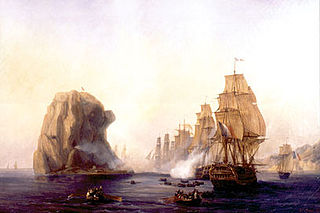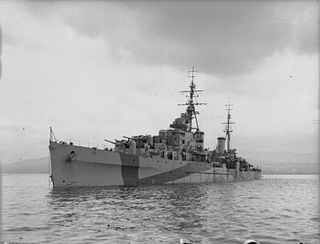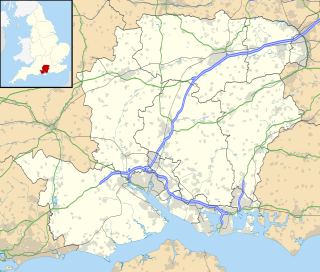
HMS Cambridge was a Royal Navy shore establishment south of Plymouth UK, commissioned between 1956 and 2001. Formerly named HM Gunnery School, Devonport, then Cambridge Gunnery School at Wembury.

The Royal Navy (RN) is the United Kingdom's naval warfare force. Although warships were used by the English kings from the early medieval period, the first major maritime engagements were fought in the Hundred Years' War against the Kingdom of France. The modern Royal Navy traces its origins to the early 16th century; the oldest of the UK's armed services, it is known as the Senior Service.

Plymouth is a port city situated on the south coast of Devon, England, approximately 37 miles (60 km) south-west of Exeter and 190 miles (310 km) west-south-west of London. Enclosing the city are the mouths of the river Plym and river Tamar, which are naturally incorporated into Plymouth Sound to form a boundary with Cornwall.

Her Majesty's Naval Base, Devonport, is the largest naval base in Western Europe and is the sole nuclear repair and refuelling facility for the Royal Navy.
The site was called HMS Cambridge after a ship of the same name an 80-gun third-rate ship of the line that was used to train seamen in gunnery in Plymouth harbour from 1856. She was replaced by the first rate HMS Windsor Castle (renamed HMS Cambridge) in 1869 before the gunnery school was moved onto land at the Plymouth naval barracks in 1907. This lasted until 1940 when a gunnery range used by the army and navy was opened at the old Wembury Point Holiday Camp (on the present site) which was named the Cambridge Gunnery School. In 1956 the school was commissioned as an independent shore establishment and was decommissioned on 30 March 2001.

HMS Cambridge was an 80-gun third rate ship of the line of the Royal Navy, launched on 23 June 1815 at Deptford Dockyard. She was built to the lines of the Danish ship Christian VII, which had been captured in 1807 at the Second Battle of Copenhagen.

In the rating system of the British Royal Navy, a third rate was a ship of the line which from the 1720s mounted between 64 and 80 guns, typically built with two gun decks. Years of experience proved that the third rate ships embodied the best compromise between sailing ability, firepower, and cost. So, while first-rates and second-rates were both larger and more powerful, the third-rate ships were in a real sense the optimal configuration.

A ship of the line was a type of naval warship constructed from the 17th through to the mid-19th century. The ship of the line was designed for the naval tactic known as the line of battle, which depended on the two columns of opposing warships maneuvering to fire with the cannons along their broadsides. In conflicts where opposing ships were both able to fire from their broadsides, the side with more cannons—and therefore more firepower—typically had an advantage. Since these engagements were almost invariably won by the heaviest ships carrying the most powerful guns, the natural progression was to build sailing vessels that were the largest and most powerful of their time.
The site was purchased in 2006 by the National Trust; the main installation, which included mounts for a range of standard naval guns, was demolished and cleared, and the site returned to nature.







